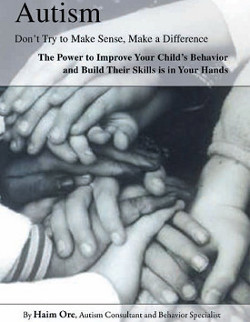Autism: Don’t Try to Make Sense. Make a Difference!

I’d like to share with you an excellent book that provides parents, caregivers, and educators techniques and strategies for dealing with the behavior of autistic children. In Haim Ore’s book, “Autism: Don’t Try to Make Sense. Make a Difference!”, Haim shares his unique ability of simplifying the science of behavior modification and presents strategies in layman’s terms.
Autism Therapist, Haim Ore has a BA in Psychology and is CEO of Creative Family Coaching Inc (CFC). CFC is an innovative organization committed to supporting and coaching families of children with Autism, as well as other developmental disorders and special needs. Haim and his experienced team provides effective and compassionate therapy and counseling specializing in academic tutoring, decreasing challenging behaviors, and increasing important life skills such as how to be more self sufficient.
The following are two excerpts from “Autism: Don’t Try to Make Sense. Make a Difference!” by Haim Ore.
How Do You Deal With A Challenging Child?
You’re frustrated your son won’t follow the simple instruction you’ve asked him to do — several times. Or your daughter has suddenly discovered the perceived power her temper tantrums hold when she hears that trigger word “No.” Perhaps you are finding yourself in a daily battle with your toddler while attempting to meet their nutritional needs. Why won’t he eat his greens? How many times do I need to ask her to go to bed?
Your options appear to be limited. Should you scold, coax, punish, bribe or trick them into complying? Should you send them to some isolated children’s boot camp so they’ll appreciate the freedom they so blissfully enjoy at home? Do you call Dr. Phil or bring in that Super Nanny? What should you do? And how did this all start anyway? When did your child give up on appropriately communicating with you? When did they stop following your requests, instructions, demands, even pleadings?
Is it your fault as a parent? Is your child genetically programmed to defy his or her loving parents? Hmmm…you wonder, and yet, for so many families these questions are left unanswered. Their child’s behavior is frustrating enough; searching for the answers is even more overwhelming. Thousands of books highlight a variety of approaches and different methodologies, and many offer conflicting information. Is there a simple and effective way to keep your child in line, a creative way to bring order to the chaos? If you are reading this book, you are likely struggling to find a solution. Well keep reading — this book is unique, written specifically for parents in your predicament.
During my years spent working with children and adults with special needs, I have come to appreciate the central theme of behavior modification, i.e., a methodology which operates along the premise of motivation rather than intimidation. Parenting is certainly not a science; most parents find themselves (unconsciously) following their own parents’ example, or mirroring the models they grew up with. Many parents use cookbooks or follow specific recipes in order to make healthy and fulfilling meals. They search for a particular “recipe” or set of effective instructions that will create a more peaceful daily life for themselves and their families. After all, I am the parent and he should listen to me!
But what if he doesn’t? Should you make him follow through? At what cost? What if there is a way to insure your child follows directions with a smile on his face instead of a disgruntled grimace? A way to eliminate the endless arguments over eating vegetables, going to bed, and completing the task you’ve assigned — the first time! How different would you be feeling as a parent if you gained compliance from your child, if these exhausting routines were eliminated from the household?
The information in this book is written for parents rather than clinicians and practitioners. It requires a willingness to give up those thorny family routines and the predictable drama attached to them. Give it a shot and I promise the contents will actually reduce your daily angst. Follow these simple yet effective suggestions and you can have a more harmonious family life. That’s right, fewer disputes and unnecessary arguments for everyone in your household — including you!
While there is no replacement for the value an experienced behavior consultant can offer in guiding you through the maze of behavior management, this book highlights the most common concerns I have come across while working with parents struggling to control their special need child. Primarily written for the parents and caregivers of children and adults diagnosed with autism or other developmental delays, I’ve nonetheless found the principles depicted and discussed to be very useful for dealing with typically developing children of all ages as well.
How Do I Know My Child’s Behavior Is a Problem?
As a parent you need to be able to distinguish between a genuine behavioral problem and conduct you simply prefer your child not engage in. I’ve had discussions with overly-concerned parents insistent on addressing behaviors which are not necessarily a big deal. For instance, a caregiver asked me to address a “behavior problem” he was concerned about. He explained how a certain child had a habit of walking back and forth in the house, repeatedly, which he found bothersome. While this may have been a nuisance, it could be easily altered by providing more outings or exercising opportunities to the child. The behavior did not meet the criteria defining it as a behavior problem. Parents also need to consider whether the behavior is typical of your child’s age group, which you determine by observing your child’s peers or after counsel with a developmental psychologist.
If the behavior meets at least one of the following criteria, you should address it:
- The child’s behavior is dangerous for his or others’ wellbeing
- The child is damaging property
- The child’s behavior disrupts the household
- The child’s behavior prevents him from performing a task he ought to be doing
- The child’s behavior is stereotyping (optional)
Let’s consider a few examples. If the child is aggressive or engages in property destruction, obviously the behavior meets the above criterion (1 and 2) and needs to be addressed. If the child tantrums each time you try to get him dressed or tell him to put his clothes on, that would meet criterion #3. If the child’s behavior is sitting on the ground and rocking, it meets criterion #5 and should be addressed, albeit optional, depending on whether the child has more urgent behavior problems meeting one or more on the above list.
Occasionally while discussing their child’s behavior, parents will relate to me: “My son does not like to do as he’s told, but I know this is typical of children his age.” It is very important to note that no parent should put up with a non-compliant child or a tantruming child. It is critical for you to understand that children do not need tantruming or defiance in order to go through life. They have acquired these habits along the way. Generally speaking, their caregiver’s allowance of such behavior reinforced it. It is up to us as teachers and parents to effect change and we can by choosing to use the most effective behavioral tools.
Book on Amazon: “Autism: Don’t Try to Make Sense. Make a Difference!”
Website: Creative Family Coaching Inc (CFC)
LinkedIn: Haim Ore
If you need any assistance, you are welcome to join our support group at: IHSS Advocacy Group
